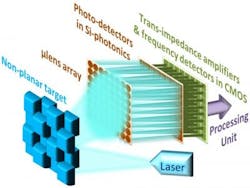Inexpensive lidar contains MEMS-tunable VCSEL
A potentially very compact and inexpensive lidar unit developed by researchers at the University of California, Berkeley (UC Berkeley) is built around a (vertical-cavity surface-emitting laser (VCSEL) that is wavelength-tunable via a movable micro-electrical-mechanical-systems (MEMS) element. The device is designed for sensing to distances of about 10 m, which is the "sweet spot" for applications such as self-driving cars, smartphone gesturing from afar, and interactive video games similar to Microsoft's Kinect.
"This [10 m] range covers the size of typical living spaces while avoiding excessive power dissipation and possible eye-safety concerns," says UC Berkeley's Behnam Behroozpour, who will present the team's work at the Optical Society's CLEO: 2014 (June 8-13, 2014; San Jose, CA).
The UC Berkeley device has the potential to be integrated into a chip-scale package. In contrast, current lasers used in high-resolution lidar imaging can be large, power-hungry, and expensive. Gaming systems require big, bulky boxes of equipment, and players have to stand within a few feet of the system for things to work properly, Behroozpour says. Bulkiness is also a problem for driverless cars such as Google's, which must carry a large 3D camera on its roof.
Frequency-modulated continuous-wave lidar
The new device is based on frequency-modulated continuous-wave (FMCW) lidar, which the UC Berkeley team felt would ensure the imager had good resolution with lower power consumption, Behroozpour says. This type of system emits frequency-chirped laser light (chirped by the resonant MEMS element in the VCSEL) and then measures changes in the light frequency that is reflected back.
"Generally, increasing the signal amplitude results in increased power dissipation," Behroozpour says. "Our solution avoids this tradeoff, thereby retaining the low power advantage of VCSELs for this application."
The team plans to integrate the VCSEL, photonics, and electronics into a chip-scale package. Consolidating these parts should open up possibilities for "a host of new applications that have not even been invented yet," Behroozpour says.
Presentation AW3H.2, titled "Method for Increasing the Operating Distance of MEMS LIDAR beyond Brownian Noise Limitation," will take place Wednesday, June 11, 2014 at 4:45 p.m. in the Room 210H of the San Jose Convention Center.

John Wallace | Senior Technical Editor (1998-2022)
John Wallace was with Laser Focus World for nearly 25 years, retiring in late June 2022. He obtained a bachelor's degree in mechanical engineering and physics at Rutgers University and a master's in optical engineering at the University of Rochester. Before becoming an editor, John worked as an engineer at RCA, Exxon, Eastman Kodak, and GCA Corporation.
